人教版(2019)必修 第一册Unit 4 Natural disasters Discovering Useful Structures课件(共29张ppt)
文档属性
| 名称 | 人教版(2019)必修 第一册Unit 4 Natural disasters Discovering Useful Structures课件(共29张ppt) | 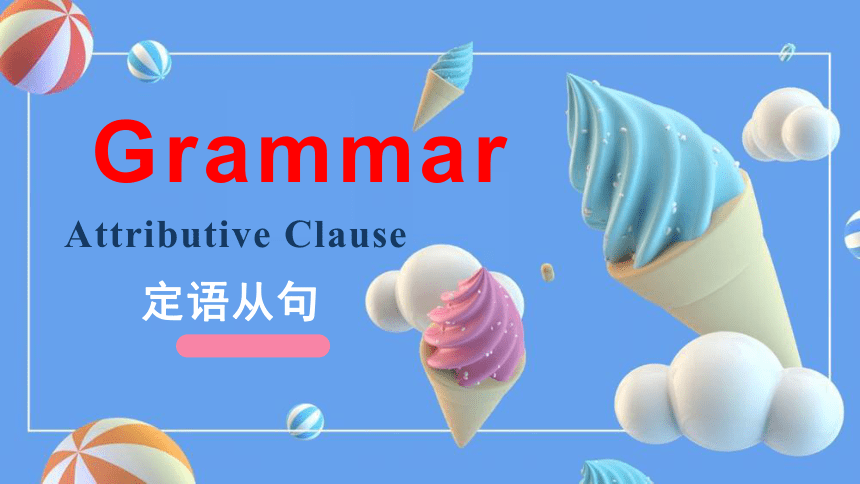 | |
| 格式 | pptx | ||
| 文件大小 | 541.5KB | ||
| 资源类型 | 教案 | ||
| 版本资源 | 人教版(2019) | ||
| 科目 | 英语 | ||
| 更新时间 | 2024-03-26 21:11:01 | ||
图片预览


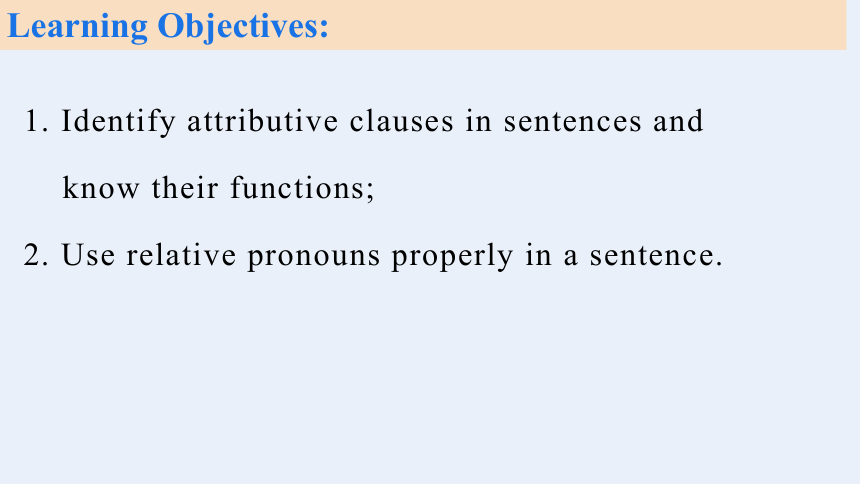
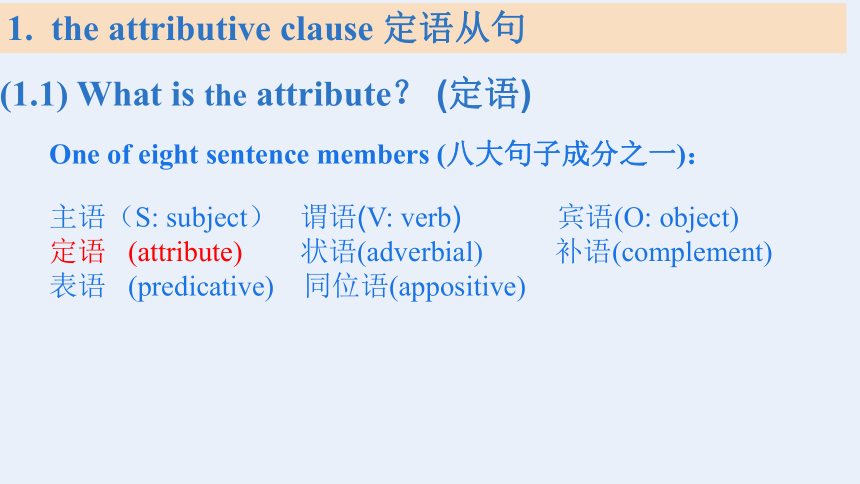
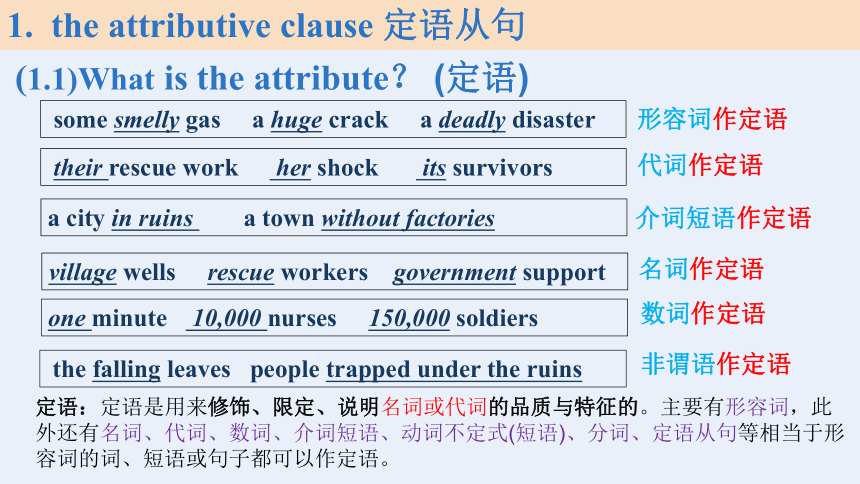
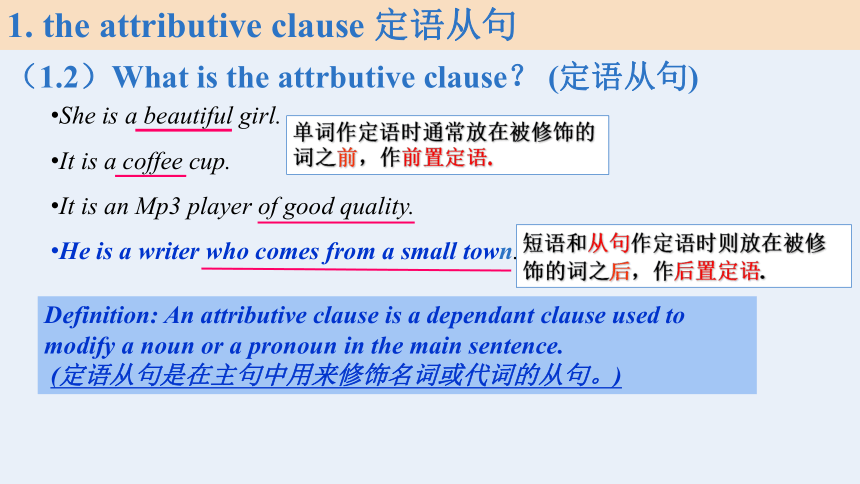
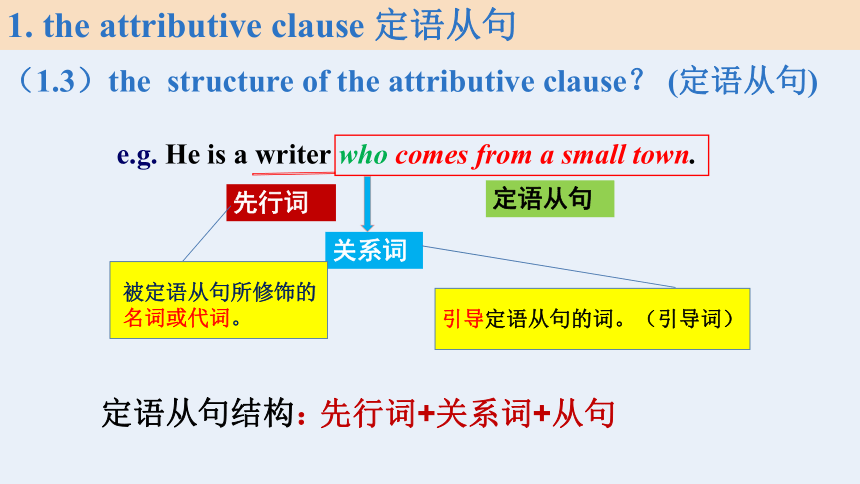
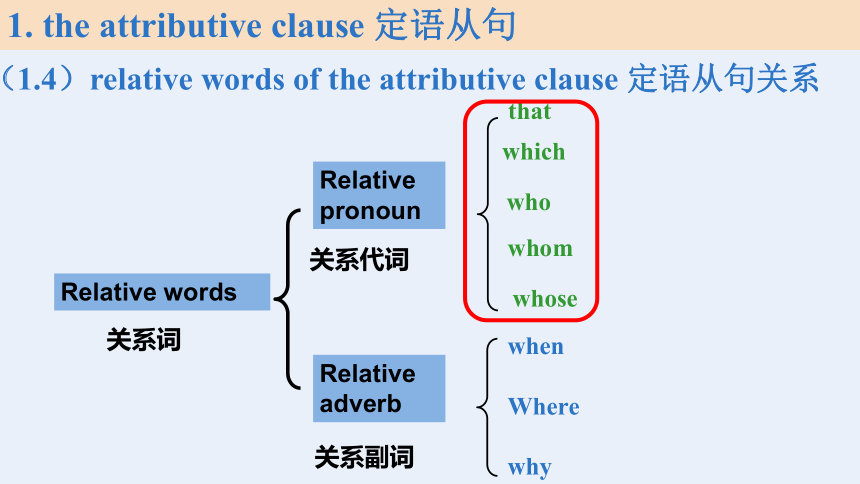
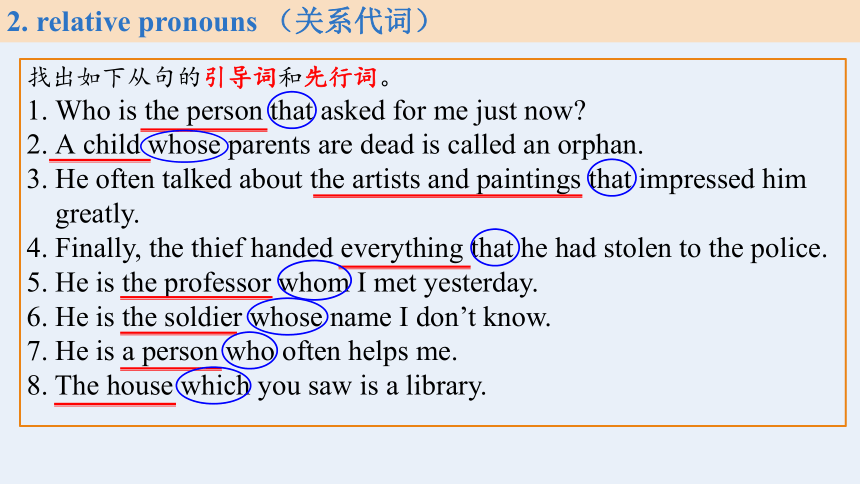
文档简介
(共29张PPT)
Grammar
Attributive Clause
定语从句
Part I attributive clause 定语从句
Part II relative pronoun 关系代词
Part III exceptional cases 特殊情况
Content 目录
1. Identify attributive clauses in sentences and
know their functions;
2. Use relative pronouns properly in a sentence.
Learning Objectives:
(1.1) What is the attribute? (定语)
One of eight sentence members (八大句子成分之一):
主语(S: subject) 谓语(V: verb) 宾语(O: object)
定语 (attribute) 状语(adverbial) 补语(complement)
表语 (predicative) 同位语(appositive)
1. the attributive clause 定语从句
(1.1)What is the attribute? (定语)
定语:定语是用来修饰、限定、说明名词或代词的品质与特征的。主要有形容词,此外还有名词、代词、数词、介词短语、动词不定式(短语)、分词、定语从句等相当于形容词的词、短语或句子都可以作定语。
1. the attributive clause 定语从句
some smelly gas a huge crack a deadly disaster
their rescue work her shock its survivors
a city in ruins a town without factories
village wells rescue workers government support
one minute 10,000 nurses 150,000 soldiers
the falling leaves people trapped under the ruins
形容词作定语
代词作定语
介词短语作定语
名词作定语
数词作定语
非谓语作定语
(1.2)What is the attrbutive clause? (定语从句)
She is a beautiful girl.
It is a coffee cup.
It is an Mp3 player of good quality.
He is a writer who comes from a small town.
单词作定语时通常放在被修饰的词之前,作前置定语.
短语和从句作定语时则放在被修饰的词之后,作后置定语.
Definition: An attributive clause is a dependant clause used to modify a noun or a pronoun in the main sentence.
(定语从句是在主句中用来修饰名词或代词的从句。)
1. the attributive clause 定语从句
先行词
定语从句
关系词
e.g. He is a writer who comes from a small town.
定语从句结构:
被定语从句所修饰的名词或代词。
引导定语从句的词。(引导词)
先行词+关系词+从句
1. the attributive clause 定语从句
(1.3)the structure of the attributive clause? (定语从句)
关系词
关系代词
关系副词
that
which
who
when
Where
why
Relative words
whose
whom
Relative pronoun
Relative adverb
1. the attributive clause 定语从句
(1.4)relative words of the attributive clause 定语从句关系
找出如下从句的引导词和先行词。
1. Who is the person that asked for me just now
2. A child whose parents are dead is called an orphan.
3. He often talked about the artists and paintings that impressed him
greatly.
4. Finally, the thief handed everything that he had stolen to the police.
5. He is the professor whom I met yesterday.
6. He is the soldier whose name I don’t know.
7. He is a person who often helps me.
8. The house which you saw is a library.
2. relative pronouns (关系代词)
We booked the flight[ which was canceled. ]
The fish[ which we ate] were fresh.
主语/宾语
物
总结:which指 ,在定语从句作 。
2. relative pronouns 关系代词
2.1 think and conclude: which
The boy [who is smiling] is Tom.
This is the person[ who I talked to ]just now.
主语/宾语
人
总结:who指 ,在定语从句作 。
2. relative pronouns 关系代词
2.2 think and conclude: who, whom
The boy[ whom I visited last week] is Tom.
The boy [whom I often go shopping with ] is Tom.
宾语
人
总结:whom指 ,在定语从句作 。
A plane is a machine [that can fly].
The noodles [that I cooked] were delicious.
The soldiers [that saved many people] are brave.
The girl [that we saw yesterday] is Jim’s sister.
主语/宾语
物
总结:that指 ,在定语从句作 。
that指 ,在定语从句作 。
2. relative pronouns 关系代词
2.3 think and conclude: that
人
主语/宾语
The house [whose door faces north] is our teachers’ office.
This is the house [whose window broke] last night.
The boy[ whose hairstyle is very impressive] is Tom.
The boy [whose father is a designer] is Mike.
定语
人/物
总结:whose= ,指 ,在定语从句作 。
2. relative pronouns 关系代词
2.4 think and conclude: whose
Whose= house’s
Whose= house’s
先行词’s(……的)
Whose= boy’s
Whose= boy’s
关系 代词 指代 在定语从句中所充当的成分
人 物 句子 主语 宾语 定语
which
who
whom
that
whose
2. relative pronouns 关系代词—summary总结
如何选择关系词:
1.找出先行词,分清人或物。
2.把先行词放进定语,看先行词在从句中充当什么成分。
一、语法填空:填入合适的关系词。
1.They planted some trees __________ didn‘t need much water.
2.She is the girl _______________ lives next door.
3.That was the boy _______________ I met on the street yesterday.
4.This is the house ____________ window broke last night.
5.Do you know the things __________ they are talking about
6.China is a country _________ has a long history.
that/which
that/who
that/who/whom
whose
that/which
which/that
Practice
二、将下列句子合并为含有定语从句的复合句。
Practice
1. There were deep cracks. Cracks appeared in the well walls.
There were deep cracks that appeared in the well walls.
2.The number of people is more than 4,000. People are killed or injured in the quake.
The number of people who are killed or injured in the quake is more than 4,0000.
3.Workers build shelters for survivors. Survivors’ homes are destroyed.
Workers build shelters for survivors whose homes are destroyed.
4. There is an earthquake. The earthquake causes damage in Beijing.
There is an earthquake that causes damage in Beijing.
Summary
1.在复合句中修饰名词或代词的从句叫定语从句。
定语从句所修饰的名词或代词叫先行词。
引导定语从句的词叫关系词。
从句 .
主句 .
(先行词)
that
which
who
whom
whose
where
how
why
3.1Think and Conclude:只能用that的情况
1. Is there anything that I can do for you
2. The only thing that he could do was waiting.
3. The last place that they visited was Beijing.
4. This is the first film that I’ve ever seen.
5. The last place that they visited was Beijing.
6. We were deeply impressed by the teachers and schools that we had visited.
7. Whoever that is content with a little progress can’t make big achievements.
8. He is no longer the man that he used to be.
9. This is no longer the dirty place (that) it used to be.
3.1Think and Conclude:只能用that的情况
先行词是 all, little, few, much, anything, everything, nothing, none, some等指物的不定代词;
2. 先行词被all, every, no, some, little, few, much, one of , the right 等所
修饰时;
3.先行词是最高级或被形容词最高级修饰时;
4.先行词是序数词或被序数词修饰时;
5.先行词中既有人又有物时;
6.先行词被 the only, the very, the same, the last 修饰时。
7.在疑问词 who、which、what开头的句子中, 要用that。
8.关系代词在定语从句中作表语只用that;
3.1Tips :小技巧
代: 不定代词-something, little
特:特指-the only, the very
高:最高级- tallest, the most beautiful
序:序数词- the first, second, third
双:指人又指物
疑:已有who, which, what
3.1Practice :
1. Luckily none of the things___________I bought were destroyed in the earthquake.
2. So we should do anything _________ can help stop smoking.
3. The first thing ______ I am going to do is to study physics.
4. Jack took photos of the things and people _______ he was interested in.
5. This is the very room ________ I slept in that evening.
6. The town is not the one __________ that it used to be.
that
that
that
that
that
that
3.2Think and Conclude:只能用which的情况
1. He gave me three books on cooking , the first of which I enjoyed most. (宾语)
2. I don’t like that which he did. (宾语)
3. In times of emergency, make an effort to keep calm, which matters most. (主语)
4.Gina’s dog, which was very old now, became ill and died.(主语)
关系代词前有介词,先行词指物时,只能用which;
(关系代词前有介词,先行词指人时,只能用whom);
先行词本身就是that或者两个定语从句中的一个已用that时。
指代完整的一件事时,只能用which;
引导非限定性定语从句时(有逗号时);
3.2Practice:
He had a bad cold, because of ________ he didn’t attend the meeting.
What’s that ________ looks like a dog.
He didn’t pass the exam, __________ made his mother angry.
She wants a pet, ________ can keep her company every day.
which
which
which
which
3.3Think and Conclude:只能用who的情况
1.Those who want to go to the cinema will have to wait at school.
2. He who doesn’t reach the Great Wall is not a true man.
3.Anyone who breaks the rules would be punished.
当先行词为指人的those, these时,只能用who;
先行词是人称代词(he,she…)时,关系代词常用who;
先行词为指人的one,someone,anyone,everyone,no one,somebody,anybody, everybody等不定代词时,关系代词用who;
3.3Practice:
Success belongs to those ________ are hardworking.
I want to help her ________ is kind.
Everybody ________ receives the reward are extremely happy.
who
who
who
3.4 tenses of attributive clauses 定语从句时态:
The professor who is visiting our school now is from Canada.
1.The professor is from Canada. He is visiting our school.
2.The professor is from Canada. He will visit our school tomorrow.
The professor who will visit our school tomorrow is from Canada.
3.The professor is from Canada. He visited our school last week.
The professor who visited our school last week is from Canada.
总结:定语从句中的时态一般不受主句影响,主要根据具体的语境和意义而定。
将下列句子合并为含有定语从句的复合句。
3.4 tenses of attributive clauses 定语从句时态:
Here is a letter from Mr. Brown, who wants to come to Paris.
1. Here is a letter from Mr. Brown. He wants to come to Paris.
2. Here is a letter from the Browns. They wants to come to Paris.
Here is a letter from the Browns, who want to come to Paris.
总结:在定语从句中,关系代词在从句中作主语时,其后谓语动词的人称和数与先行词保持一致。
将下列句子合并为含有定语从句的复合句。
3.4 tenses of attributive clauses 定语从句时态:
He is one of the students in Class One who are often late.
1. He is one of the students in Class One. He is often late.
2. He is the only one of the students in Class One. He is often late.
He is the one only of the students in Class One who is often late.
总结:
one of + 复数名词 + 定语从句 谓语动词用复数
the (only)one of + 复数名词 + 定语从句 谓语动词用单数
将下列句子合并为含有定语从句的复合句。
Thank you !
Grammar
Attributive Clause
定语从句
Part I attributive clause 定语从句
Part II relative pronoun 关系代词
Part III exceptional cases 特殊情况
Content 目录
1. Identify attributive clauses in sentences and
know their functions;
2. Use relative pronouns properly in a sentence.
Learning Objectives:
(1.1) What is the attribute? (定语)
One of eight sentence members (八大句子成分之一):
主语(S: subject) 谓语(V: verb) 宾语(O: object)
定语 (attribute) 状语(adverbial) 补语(complement)
表语 (predicative) 同位语(appositive)
1. the attributive clause 定语从句
(1.1)What is the attribute? (定语)
定语:定语是用来修饰、限定、说明名词或代词的品质与特征的。主要有形容词,此外还有名词、代词、数词、介词短语、动词不定式(短语)、分词、定语从句等相当于形容词的词、短语或句子都可以作定语。
1. the attributive clause 定语从句
some smelly gas a huge crack a deadly disaster
their rescue work her shock its survivors
a city in ruins a town without factories
village wells rescue workers government support
one minute 10,000 nurses 150,000 soldiers
the falling leaves people trapped under the ruins
形容词作定语
代词作定语
介词短语作定语
名词作定语
数词作定语
非谓语作定语
(1.2)What is the attrbutive clause? (定语从句)
She is a beautiful girl.
It is a coffee cup.
It is an Mp3 player of good quality.
He is a writer who comes from a small town.
单词作定语时通常放在被修饰的词之前,作前置定语.
短语和从句作定语时则放在被修饰的词之后,作后置定语.
Definition: An attributive clause is a dependant clause used to modify a noun or a pronoun in the main sentence.
(定语从句是在主句中用来修饰名词或代词的从句。)
1. the attributive clause 定语从句
先行词
定语从句
关系词
e.g. He is a writer who comes from a small town.
定语从句结构:
被定语从句所修饰的名词或代词。
引导定语从句的词。(引导词)
先行词+关系词+从句
1. the attributive clause 定语从句
(1.3)the structure of the attributive clause? (定语从句)
关系词
关系代词
关系副词
that
which
who
when
Where
why
Relative words
whose
whom
Relative pronoun
Relative adverb
1. the attributive clause 定语从句
(1.4)relative words of the attributive clause 定语从句关系
找出如下从句的引导词和先行词。
1. Who is the person that asked for me just now
2. A child whose parents are dead is called an orphan.
3. He often talked about the artists and paintings that impressed him
greatly.
4. Finally, the thief handed everything that he had stolen to the police.
5. He is the professor whom I met yesterday.
6. He is the soldier whose name I don’t know.
7. He is a person who often helps me.
8. The house which you saw is a library.
2. relative pronouns (关系代词)
We booked the flight[ which was canceled. ]
The fish[ which we ate] were fresh.
主语/宾语
物
总结:which指 ,在定语从句作 。
2. relative pronouns 关系代词
2.1 think and conclude: which
The boy [who is smiling] is Tom.
This is the person[ who I talked to ]just now.
主语/宾语
人
总结:who指 ,在定语从句作 。
2. relative pronouns 关系代词
2.2 think and conclude: who, whom
The boy[ whom I visited last week] is Tom.
The boy [whom I often go shopping with ] is Tom.
宾语
人
总结:whom指 ,在定语从句作 。
A plane is a machine [that can fly].
The noodles [that I cooked] were delicious.
The soldiers [that saved many people] are brave.
The girl [that we saw yesterday] is Jim’s sister.
主语/宾语
物
总结:that指 ,在定语从句作 。
that指 ,在定语从句作 。
2. relative pronouns 关系代词
2.3 think and conclude: that
人
主语/宾语
The house [whose door faces north] is our teachers’ office.
This is the house [whose window broke] last night.
The boy[ whose hairstyle is very impressive] is Tom.
The boy [whose father is a designer] is Mike.
定语
人/物
总结:whose= ,指 ,在定语从句作 。
2. relative pronouns 关系代词
2.4 think and conclude: whose
Whose= house’s
Whose= house’s
先行词’s(……的)
Whose= boy’s
Whose= boy’s
关系 代词 指代 在定语从句中所充当的成分
人 物 句子 主语 宾语 定语
which
who
whom
that
whose
2. relative pronouns 关系代词—summary总结
如何选择关系词:
1.找出先行词,分清人或物。
2.把先行词放进定语,看先行词在从句中充当什么成分。
一、语法填空:填入合适的关系词。
1.They planted some trees __________ didn‘t need much water.
2.She is the girl _______________ lives next door.
3.That was the boy _______________ I met on the street yesterday.
4.This is the house ____________ window broke last night.
5.Do you know the things __________ they are talking about
6.China is a country _________ has a long history.
that/which
that/who
that/who/whom
whose
that/which
which/that
Practice
二、将下列句子合并为含有定语从句的复合句。
Practice
1. There were deep cracks. Cracks appeared in the well walls.
There were deep cracks that appeared in the well walls.
2.The number of people is more than 4,000. People are killed or injured in the quake.
The number of people who are killed or injured in the quake is more than 4,0000.
3.Workers build shelters for survivors. Survivors’ homes are destroyed.
Workers build shelters for survivors whose homes are destroyed.
4. There is an earthquake. The earthquake causes damage in Beijing.
There is an earthquake that causes damage in Beijing.
Summary
1.在复合句中修饰名词或代词的从句叫定语从句。
定语从句所修饰的名词或代词叫先行词。
引导定语从句的词叫关系词。
从句 .
主句 .
(先行词)
that
which
who
whom
whose
where
how
why
3.1Think and Conclude:只能用that的情况
1. Is there anything that I can do for you
2. The only thing that he could do was waiting.
3. The last place that they visited was Beijing.
4. This is the first film that I’ve ever seen.
5. The last place that they visited was Beijing.
6. We were deeply impressed by the teachers and schools that we had visited.
7. Whoever that is content with a little progress can’t make big achievements.
8. He is no longer the man that he used to be.
9. This is no longer the dirty place (that) it used to be.
3.1Think and Conclude:只能用that的情况
先行词是 all, little, few, much, anything, everything, nothing, none, some等指物的不定代词;
2. 先行词被all, every, no, some, little, few, much, one of , the right 等所
修饰时;
3.先行词是最高级或被形容词最高级修饰时;
4.先行词是序数词或被序数词修饰时;
5.先行词中既有人又有物时;
6.先行词被 the only, the very, the same, the last 修饰时。
7.在疑问词 who、which、what开头的句子中, 要用that。
8.关系代词在定语从句中作表语只用that;
3.1Tips :小技巧
代: 不定代词-something, little
特:特指-the only, the very
高:最高级- tallest, the most beautiful
序:序数词- the first, second, third
双:指人又指物
疑:已有who, which, what
3.1Practice :
1. Luckily none of the things___________I bought were destroyed in the earthquake.
2. So we should do anything _________ can help stop smoking.
3. The first thing ______ I am going to do is to study physics.
4. Jack took photos of the things and people _______ he was interested in.
5. This is the very room ________ I slept in that evening.
6. The town is not the one __________ that it used to be.
that
that
that
that
that
that
3.2Think and Conclude:只能用which的情况
1. He gave me three books on cooking , the first of which I enjoyed most. (宾语)
2. I don’t like that which he did. (宾语)
3. In times of emergency, make an effort to keep calm, which matters most. (主语)
4.Gina’s dog, which was very old now, became ill and died.(主语)
关系代词前有介词,先行词指物时,只能用which;
(关系代词前有介词,先行词指人时,只能用whom);
先行词本身就是that或者两个定语从句中的一个已用that时。
指代完整的一件事时,只能用which;
引导非限定性定语从句时(有逗号时);
3.2Practice:
He had a bad cold, because of ________ he didn’t attend the meeting.
What’s that ________ looks like a dog.
He didn’t pass the exam, __________ made his mother angry.
She wants a pet, ________ can keep her company every day.
which
which
which
which
3.3Think and Conclude:只能用who的情况
1.Those who want to go to the cinema will have to wait at school.
2. He who doesn’t reach the Great Wall is not a true man.
3.Anyone who breaks the rules would be punished.
当先行词为指人的those, these时,只能用who;
先行词是人称代词(he,she…)时,关系代词常用who;
先行词为指人的one,someone,anyone,everyone,no one,somebody,anybody, everybody等不定代词时,关系代词用who;
3.3Practice:
Success belongs to those ________ are hardworking.
I want to help her ________ is kind.
Everybody ________ receives the reward are extremely happy.
who
who
who
3.4 tenses of attributive clauses 定语从句时态:
The professor who is visiting our school now is from Canada.
1.The professor is from Canada. He is visiting our school.
2.The professor is from Canada. He will visit our school tomorrow.
The professor who will visit our school tomorrow is from Canada.
3.The professor is from Canada. He visited our school last week.
The professor who visited our school last week is from Canada.
总结:定语从句中的时态一般不受主句影响,主要根据具体的语境和意义而定。
将下列句子合并为含有定语从句的复合句。
3.4 tenses of attributive clauses 定语从句时态:
Here is a letter from Mr. Brown, who wants to come to Paris.
1. Here is a letter from Mr. Brown. He wants to come to Paris.
2. Here is a letter from the Browns. They wants to come to Paris.
Here is a letter from the Browns, who want to come to Paris.
总结:在定语从句中,关系代词在从句中作主语时,其后谓语动词的人称和数与先行词保持一致。
将下列句子合并为含有定语从句的复合句。
3.4 tenses of attributive clauses 定语从句时态:
He is one of the students in Class One who are often late.
1. He is one of the students in Class One. He is often late.
2. He is the only one of the students in Class One. He is often late.
He is the one only of the students in Class One who is often late.
总结:
one of + 复数名词 + 定语从句 谓语动词用复数
the (only)one of + 复数名词 + 定语从句 谓语动词用单数
将下列句子合并为含有定语从句的复合句。
Thank you !
